Bibcode
Dallilar, Y.; Eikenberry, Stephen S.; Garner, Alan; Stelter, Richard D.; Gottlieb, Amy; Gandhi, Poshak; Casella, Piergiorgio; Dhillon, V. S.; Marsh, Tom R.; Littlefair, Stuart P.; Hardy, Liam; Fender, Rob; Mooley, Kunal; Walton, Dominic J.; Fuerst, Felix; Bachetti, Matteo; Castro-Tirado, A. J.; Charcos, Miguel; Edwards, Michelle L.; Lasso-Cabrera, Nestor M.; Marin-Franch, Antonio; Raines, S. Nicholas; Ackley, Kendall; Bennett, John G.; Cenarro, A. Javier; Chinn, Brian; Donoso, H. Veronica; Frommeyer, Raymond; Hanna, Kevin; Herlevich, Michael D.; Julian, Jeff; Miller, Paola; Mullin, Scott; Murphey, Charles H.; Packham, Chris; Varosi, Frank; Vega, Claudia; Warner, Craig; Ramaprakash, A. N.; Burse, Mahesh; Punnadi, Sujit; Chordia, Pravin; Gerarts, Andreas; de Paz Martín, Héctor; Calero, María Martín; Scarpa, R.; Acosta, Sergio Fernandez; Hernández Sánchez, William Miguel; Siegel, Benjamin; Pérez, Francisco Francisco; Viera Martín, Himar D.; Rodríguez Losada, José A.; Nuñez, Agustín; Tejero, Álvaro; Martín González, Carlos E.; Rodríguez, César Cabrera; Molgó, Jordi; Rodriguez, J. Esteban; Cáceres, J. Israel Fernández; Rodríguez García, Luis A.; Lopez, Manuel Huertas; Dominguez, Raul; Gaggstatter, Tim; Lavers, Antonio Cabrera; Geier, S.; Pessev, P.; Sarajedini, Ata
Bibliographical reference
Science, Volume 358, Issue 6368, pp. 1299-1302 (2017).
Advertised on:
12
2017
Journal
Citations
30
Refereed citations
28
Description
Observations of binary stars containing an accreting black hole or
neutron star often show x-ray emission extending to high energies
(>10 kilo–electron volts), which is ascribed to an
accretion disk corona of energetic particles akin to those seen in the
solar corona. Despite their ubiquity, the physical conditions in
accretion disk coronae remain poorly constrained. Using simultaneous
infrared, optical, x-ray, and radio observations of the Galactic black
hole system V404 Cygni, showing a rapid synchrotron cooling event in its
2015 outburst, we present a precise 461 ± 12 gauss magnetic field
measurement in the corona. This measurement is substantially lower than
previous estimates for such systems, providing constraints on physical
models of accretion physics in black hole and neutron star binary
systems.
Related projects

Formation and Evolution of Galaxies: Observations in Infrared and other Wavelengths
This IAC research group carries out several extragalactic projects in different spectral ranges, using space as well as ground-based telescopes, to study the cosmological evolution of galaxies and the origin of nuclear activity in active galaxies. The group is a member of the international consortium which built the SPIRE instrument for the
Ismael
Pérez Fournon